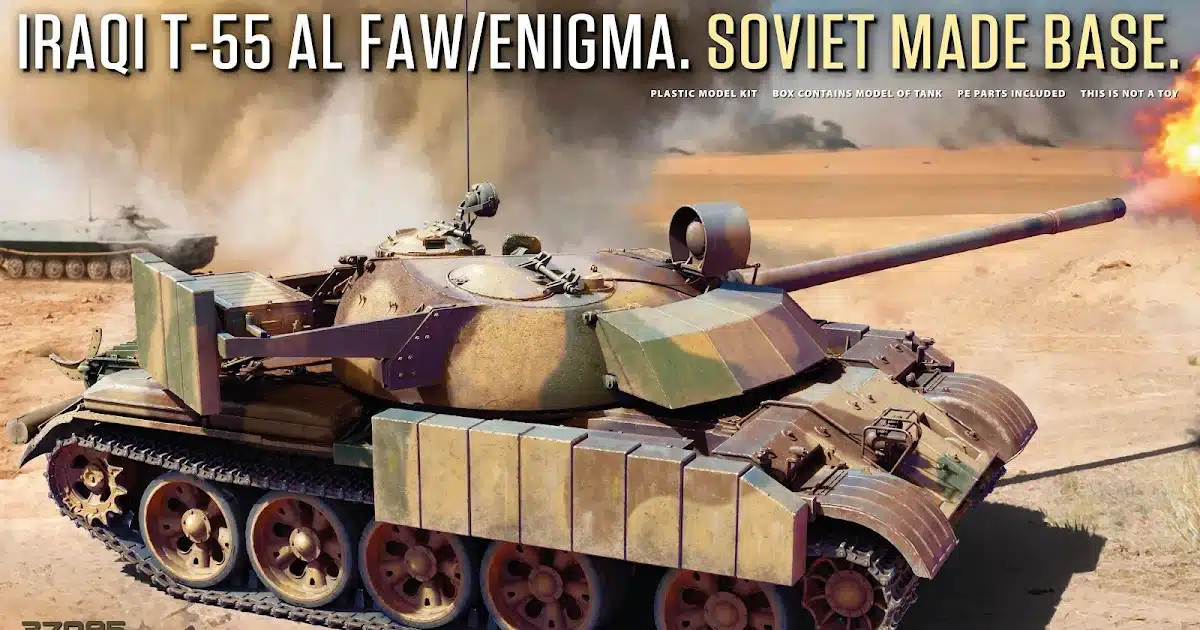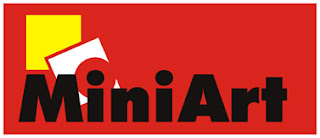Our preview will tell you more about this “Enigma” & the CAD images of the kit. See more about this “Enigma” & the CAD images of the kit in our preview…
T-55 Iraqi T-55 AL FAW/Enigma. Soviet Made Base
From MiniArt
1/35th scale
Kit No#37095
Two marking choices in this box
The Subject: the Iraqi T-55 AL FAW/Enigma. In 1973, Iraq purchased 300 T55 tanks to replace the tanks lost during the Yom Kippur War. It also acquired 1500 Chinese Type 59 and Type 69 tank from the Soviet Union and Poland in the 1980s. The Iran-Iraq War, which took place from 1980 to 1988, saw a large number of tanks destroyed. By the 1980s, aside from having outdated firepower, T-55 tanks’ protection was laughable. They developed a kit in order to improve this. The Warsaw Pact M-Series armor upgrade for T-55s and T-62s, which combined polyurethane and angled steel plate to stop HEAT projectiles coming from the front (such as guided missiles or RPGs), was the inspiration behind this armor kit. Iraqis knew the potential danger of these weapons, but their technology was severely limited. The turret armor boxes were made of 5mm steel and five or six composite plates. Five or six such composite plates formed the inside of the turret armor boxes made of 5mm steel plates.
T-55 Iraqi T-55 AL FAW/Enigma at the Aberdeen proving ground in the USA
The armor kit for the T-55 and its Chinese clones, consisted of:
-Turret front: additional armor on both sides
-Turret rear: extended armor acting as a counterweight to the additional frontal armor, keeping the turret balanced
-Hull front: additional armor kit
-Hull sides: thick boxy “skirts” on the frontal part of the tank’s flanks
-Armored housing for the tank’s searchlight and IR light
The turret armour lifted to show thickness.
The entire kit weighed roughly 4 tons, adding approximately 10 percent of extra weight to the tank carrying it without any engine power increase, leading – allegedly – to somewhat reduced mobility and reliability. First prototype of the kit was displayed to the public around 1988/89. It is believed that it was based off a Type 69. The kit lacked a turret weight counterweight, but it had two smoke grenade launchers. This was not available on the production variant. Unknown numbers of T-55 (or Chinese version) tanks were then modified. Estimates range between 8 and 12 vehicles. The Enigma tank at Bovington Tank Museum
Their designation is not known, but some sources claim that the Iraqis called them “Al Faw”. T-55 Enigma is an unofficial name that likely came about after Operation Desert Storm, when news of the tanks began to reach the West and no one knew exactly what it was. The name was adopted.
The remainder, as the saying goes, is history. The Enigmas were lost in the invasion of Iraq by the Coalition. These tanks weren’t very useful as combat vehicles. These tanks were only deployed in a single battle in the Battle of Khaffji, in late January of 1991, as part of the 5th Iraqi Mechanized Division. They made little difference. After all, underneath the massive-looking armor upgrade, the Enigma was still an obsolete T-55.
The counterweight is installed on the turret
However, the armor upgrade itself might have not been as useless as the Iraqi military performance would suggest. According to several reports, the tank is actually quite resistant against MILAN ATGMs. It is hard to say how much is accurate. Other reports do mention them exploding just like any other obsolete Soviet tech on the battlefield.
Whether the Iraqis believed the upgrade was actually viable is an interesting topic though. Before the invasion of Iraq, the author had the opportunity to speak with an individual stationed there who told him a fascinating story. The Iraqis, according to the story of this man who was stationed in the Middle East before invasion received 125mm kinetic round with cores made from soft steel. They then fired these shells at an upgraded “T-55” which resisted them well, leading the Iraqis to overestimate its effectiveness. Such naivety was allegedly not uncommon in the Middle East.
A knocked out Enigma after the Battle of Khafji.



.webp)
.webp)
.webp)

.webp)